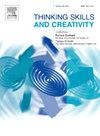弥合STEM中的性别差距:自我信念对中学生特定领域创造力的影响
IF 4.5
2区 教育学
Q1 Social Sciences
引用次数: 0
摘要
越来越多的人认识到,学校课程中的创造性思维是解决科学、技术、工程和数学(STEM)领域性别差距的可能解决方案。研究表明,强调创造力的教学方法可能会培养女学生更大的参与度、兴趣和科学认同感。然而,这些努力往往忽略了一个事实,即女学生可能对自己的创造能力缺乏信心,这可能会限制只关注创造力的认知维度(如创造性思维)的方法的有效性。本研究探讨了澳大利亚中学生在STEM创造力方面的性别差异(N = 913),特别是在创造力的情感维度上的差异,即学生的创造性自我信念。研究结果揭示了一个令人担忧的模式:尽管女性在一般领域表现出更高的创造潜力,但与男性相比,女性对自己在科学环境中的创造性表现缺乏信心。研究结果强调,迫切需要制定既能满足创造力的认知维度又能满足情感维度的教育策略,以确保女学生能够有效地将她们的创造潜力转化为STEM领域的表现。对课堂教育者、学校领导和政策制定者的实际意义进行了讨论,包括在课堂上使用创新的教学方法和在课程中重新定义创造力。本文章由计算机程序翻译,如有差异,请以英文原文为准。
Bridging the gender gap in STEM: The impact of self-beliefs on domain-specific creativity among secondary students
There is a growing recognition of creative thinking in school curricula as a possible solution to address the gender gap in the fields of Science, Technology, Engineering, and Mathematics (STEM). This is supported by research suggesting that pedagogical approaches which emphasise creativity may foster greater engagement, interest, and science identity among female students. However, these efforts often overlook that female students may have lower confidence in their creative abilities, which can limit the effectiveness of approaches that focus only on the cognitive dimensions of creativity, such as creative thinking. This study explores gender differences in STEM creativity among secondary school students in Australia (N = 913), specifically examining disparities in the affective dimension of creativity—that is, students' creative self-beliefs. The findings reveal a concerning pattern: despite exhibiting higher domain-general creative potential, females display less confidence in their creative performance within scientific settings compared to males. The results emphasize the urgent need for educational strategies that cater to both the cognitive and affective dimensions of creativity, ensuring that female students can effectively convert their creative potential into performance in STEM fields. Practical implications for classroom educators, school leaders, and policymakers are discussed, including the use of innovative pedagogical approaches in the classroom and the redefinition of creativity in the curriculum.
求助全文
通过发布文献求助,成功后即可免费获取论文全文。
去求助
来源期刊

Thinking Skills and Creativity
EDUCATION & EDUCATIONAL RESEARCH-
CiteScore
6.40
自引率
16.20%
发文量
172
审稿时长
76 days
期刊介绍:
Thinking Skills and Creativity is a new journal providing a peer-reviewed forum for communication and debate for the community of researchers interested in teaching for thinking and creativity. Papers may represent a variety of theoretical perspectives and methodological approaches and may relate to any age level in a diversity of settings: formal and informal, education and work-based.
 求助内容:
求助内容: 应助结果提醒方式:
应助结果提醒方式:


